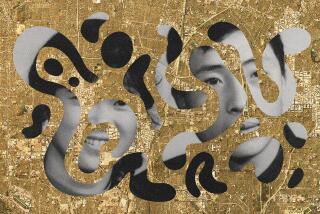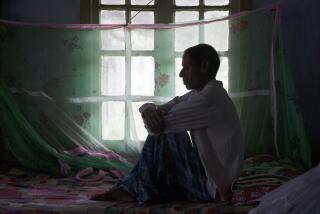Crossing Cultures in the Fight Against Tuberculosis : Public health: More than 400 new cases--mostly among Asian and Latino immigrants--were reported in Orange County last year. Officials are trying new tactics in treating the disease.
COSTA MESA — When Orange County public health worker Minh Luyen asks Vietnamese tuberculosis patients why they are not taking their medicine, they often complain that it makes them feel too hot. Their culture, she notes, values a balance of cold and heat. Luyen does not argue but strongly recommends that they take their daily dose of pills and then cool off by drinking lots of water and eating fruit and vegetables.
Understanding other cultures has become essential for public health workers, who are fighting a dramatic rise in tuberculosis cases in Orange County, mostly among Asian and Latino immigrants.
Last year, the number of new tuberculosis cases reported in the county increased to 411--a 35% jump over 1991, the greatest hike in 10 years. Southeast Asians accounted for 58% of the new cases, Latinos 19% and Anglos 18%.
In comparison, Los Angeles County, with more than five times as many cases--2,208 recorded in 1992--witnessed a 6.4% increase in tuberculosis cases since 1991.
Orange County officials blame the increase largely on a change in immigration law that since June, 1991, has allowed TB-infected immigrants into the United States if their disease is not contagious.
Officials point to a near-doubling of the number of immigrants who arrive in Orange County with test results showing that they may have TB. In 1992, the number of potential TB cases increased to 1,630 from 821 the previous year, county health authorities said.
Orange County has escaped the outbreaks of drug-resistant tuberculosis strains that have killed victims, especially HIV-infected patients, in New York City and Miami. So far, the disease has not struck with any force in Orange County’s highly susceptible HIV population or in its nursing homes, hospitals, prisons, schools or homeless shelters--places where it could easily spread.
Some health officials worry that the potential exists here for TB to infiltrate high-risk groups and for drug-resistant strains to develop. Therefore, they are monitoring the groups and evaluating the county’s TB screening programs.
“The epidemic back East has served to increase everybody’s awareness,” said Dr. Lauri Thrupp, chief of infection control at UC Irvine Medical Center in Orange. Thrupp said he advocates more strict adherence to TB skin testing of immigrant patients.
Although modern medicine has provided drugs to cure the disease that once was a major killer, tuberculosis can wreak havoc if it is allowed to run its course.
“You can die from untreated TB,” said Dr. Margaret Tipple, an assistant director at the Centers for Disease Control and Prevention in Atlanta.
TB is a lung disease transmitted from person to person by bacteria coughed into the air. The ethnic groups most afflicted with TB, health officials say, harbor the disease mostly within their immediate families because they share the same breathing space. They are not considered a health risk to the public.
The arrival of thousands of Vietnamese refugees in Orange County in the late 1970s triggered a marked resurgence of TB. At that time, the county responded by establishing a refugee health screening program.
But the TB threat has rebounded.
According to the California Department of Health Services, Orange County in 1991 had the fourth-largest number of tuberculosis victims among 25 counties surveyed.
Los Angeles County topped that list, with 2,121 new patients counted in 1991 and 2,208 recorded last year.
“Our numbers have climbed steadily since 1989,” said Dr. Shirley Fannin, director of disease control programs for Los Angeles County. Fannin said about 65% of new cases since 1989 are in new immigrants.
Although the largest increase in TB cases last year was among Southeast Asians, the disease has always been prevalent among Southern California’s Latino immigrant community because of movement from Mexico and other Latin nations where TB is common.
Health workers say it is difficult to eradicate tuberculosis because of the lengthy treatment regimen; at least six months of daily medication and monthly checkups are necessary. And people with contagious TB must stay home--avoiding workplaces, shopping malls, churches and similar areas where they could infect others--until the medication arrests the contagious stage of the disease.
County health officials say to ensure compliance, they are increasing the use of outreach workers, who deliver pills daily to problem patients and wait for them to swallow the medication. About 60 patients are on such programs.
“If they don’t have symptoms, they don’t believe they are sick,” said social worker Luyen, who is bilingual and works primarily in the Vietnamese community.
Luyen said that those who neglect taking their TB medication are often preoccupied with what they believe are more pressing concerns--such as learning English and getting a job.
In Vietnam, she said, few receive treatment for TB. “If they cough, they eat citrus, like kumquats, that thins out the phlegm,” she said.
Centers for Disease Control physicians say the complaint among some Vietnamese immigrants that the medication makes them feel hot is legitimate because the drugs can produce such side effects as tiredness, hot flushes and nausea. But taking pills is a vast improvement from decades ago, when TB sufferers were isolated in sanitariums.
Tuan Quoc Nguyen, 21, a new immigrant being tested for tuberculosis last week at a Santa Ana refugee clinic, said many Vietnamese in his homeland cannot afford medications--even if they could find a pharmacy that stocked them.
Nguyen, whose chest X-ray at a refugee camp indicated that he might have TB, was grateful to go to the clinic for a more certain diagnosis. “It is good to have treatment when you need it,” he said.
Times staff writer Douglas P. Shuit contributed to this story from Los Angeles.
* TB Rates Around the State CITY RATES Both Los Angeles and Santa Ana were among the California cities of 250,000 or more residents with the highest TB rates per 100,000 in 1991. The highest rate in the country was in Atlanta: 76.4.
City Rate Cases U.S. rank * San Francisco 46.0 334 5 * Oakland 40.9 154 6 * Los Angeles 30.6 1,081 9 * Santa Ana 30.0 90 10 * Long Beach 24.8 109 15 * San Jose 23.2 184 18 * Sacramento 22.7 85 19 * San Diego 19.3 218 24 * Anaheim 15.0 41 33 * Fresno 14.7 54 34
Source: California Department of Health Services * Tuberculosis Threat Tuberculosis is spreading swiftly in Orange County, with 35% more new cases in 1992 than in 1991. In comparison, Los Angeles County saw an increase of 6.4% in the same period. Orange County Population: 2,477,700 (1991 est.) Cases in 1992: 411 Rate per 100,000 residents in 1992: 16.4 Los Angeles County Population: 9,003,500 (1991 est.) Cases in 1992: 2,208 Rate per 100,000 residents in 1992: 26.4 Sources: Orange County Health Care Agency, California Department of Health Services, Los Angeles County Disease Control Programs
More to Read
Sign up for Essential California
The most important California stories and recommendations in your inbox every morning.
You may occasionally receive promotional content from the Los Angeles Times.









